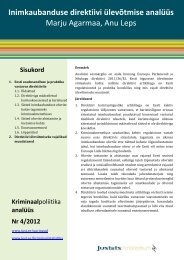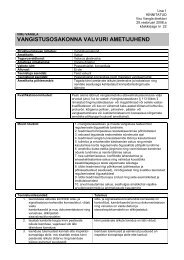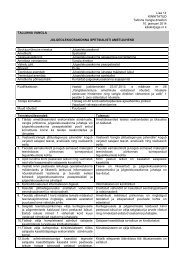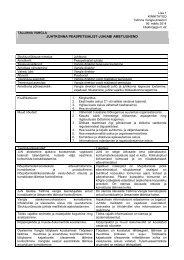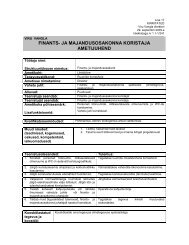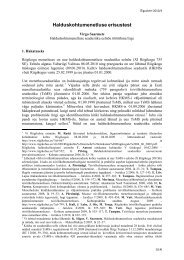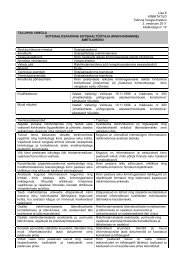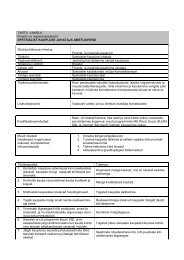11. Retsidiivsus Eestis - Justiitsministeerium
11. Retsidiivsus Eestis - Justiitsministeerium
11. Retsidiivsus Eestis - Justiitsministeerium
Create successful ePaper yourself
Turn your PDF publications into a flip-book with our unique Google optimized e-Paper software.
RETSIDIIVSUS EESTIS 2010<br />
5. RECIDIVISM OF PEOPLE RELEASED FROM PRISON AND FACTORS INFLUENCING IT<br />
RETSIDIIVSUS EESTIS 2010<br />
5.5. Recidivism of people released from prison by<br />
socio-demographic characteristics<br />
Next, the commission of any type of criminal offences by people released<br />
from prison within one year and two years after release by various sociodemographic<br />
characteristics and characteristics reflecting criminal career is<br />
addressed.<br />
5.5.2. Age of criminal offenders<br />
The recidivism rate has been the highest among people imprisoned as minors<br />
and has decreased with aging. No clear changes in the recidivism rate of<br />
people released in 2004-2007 became apparent.<br />
5.5.1. Sex of criminal offenders<br />
In general, the recidivism of men exceeded the recidivism of women both<br />
by one year and two years (except in case of people released in 2006 when<br />
the indicator of women was relatively high). Within one year, a new criminal<br />
offence was committed by 41%-44% of men and on the average by one third<br />
of women.<br />
Figure 31. The proportion of people who committed a new criminal offence of any<br />
type within 12 months after release by age and year of release from prison (% from<br />
all people released in every age group)<br />
Figure 30. The proportion of people who committed a new criminal offence of<br />
any type within 12 months after release from prison by sex and year of release (%)<br />
With respect to men released in 2004-2006 the same indicator was higher<br />
by 14-15 percentage points within two years after release than in case of one<br />
year, staying in the range 55%-59%. Due to a small number of women the<br />
indicators were more variable and the proportion of women who committed a<br />
new criminal offence reached from 41% (women released in 2005) up to 55%<br />
(women released in 2006).<br />
Within two years after release from prison, a new criminal offence was<br />
committed by more than two thirds of people who commence serving their<br />
sentence as minors. In the 18-26 year age group the recidivism rate remained<br />
in the range 60%-64% and in case of 27-35 year people on the level of 56%.<br />
From 45 year old people a new criminal offence was committed within two<br />
years after release by less than 45%.<br />
5.5.3. Education of criminal offenders<br />
During the observation period, the recidivism has stably remained the highest<br />
in case of people with primary education and the lowest in case of people<br />
with higher education; this indicator has been rather variable in case of people<br />
with vocational education (for the last two groups the number of people has<br />
206<br />
207



